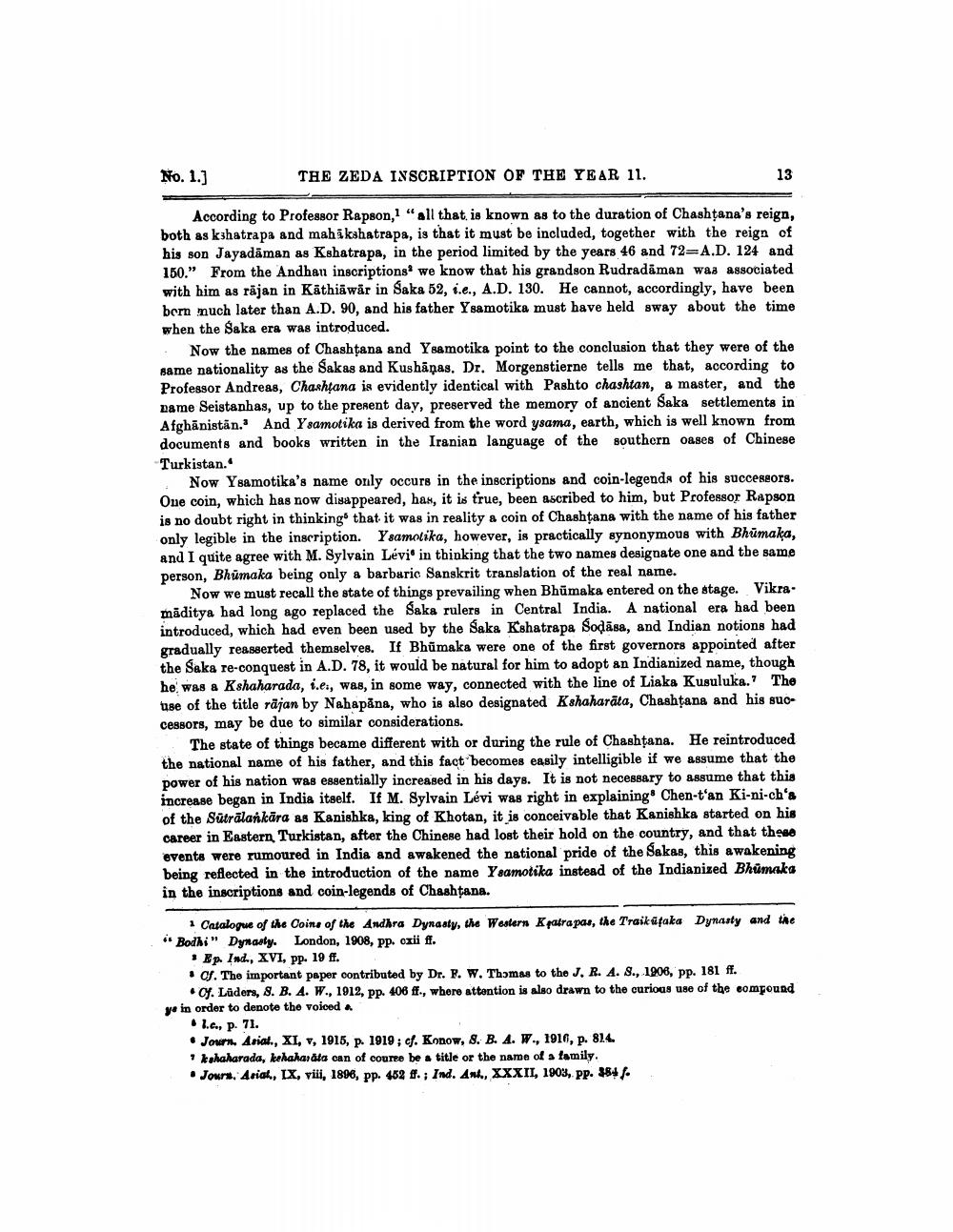________________
No. 1.]
THE ZEDA INSCRIPTION OF THE YEAR 11.
According to Professor Rapson,1 "all that is known as to the duration of Chashtana's reign, both as kshatrapa and mahakshatrapa, is that it must be included, together with the reign of his son Jayadaman as Kshatrapa, in the period limited by the years 46 and 72=A.D. 124 and 150." From the Andhau inscriptions we know that his grandson Rudradaman was associated with him as rajan in Kathiawar in Saka 52, i.e., A.D. 130. He cannot, accordingly, have been bern much later than A.D. 90, and his father Ysamotika must have held sway about the time when the Saka era was introduced.
13
Now the names of Chashtana and Ysamotika point to the conclusion that they were of the same nationality as the Sakas and Kushanas. Dr. Morgenstierne tells me that, according to Professor Andreas, Chashtana is evidently identical with Pashto chashtan, a master, and the name Seistanhas, up to the present day, preserved the memory of ancient Saka settlements in Afghanistan. And Ysamotika is derived from the word ysama, earth, which is well known from documents and books written in the Iranian language of the southern oases of Chinese Turkistan."
Now Ysamotika's name only occurs in the inscriptions and coin-legends of his successors. One coin, which has now disappeared, has, it is true, been ascribed to him, but Professor Rapson is no doubt right in thinking that it was in reality a coin of Chashtana with the name of his father only legible in the inscription. Ysamotika, however, is practically synonymous with Bhumaka, and I quite agree with M. Sylvain Lévi in thinking that the two names designate one and the same person, Bhumaka being only a barbaric Sanskrit translation of the real name.
Now we must recall the state of things prevailing when Bhumaka entered on the stage. Vikramaditya had long ago replaced the Saka rulers in Central India. A national era had been introduced, which had even been used by the Saka Kshatrapa Sodasa, and Indian notions had gradually reasserted themselves. If Bhumaka were one of the first governors appointed after the Saka re-conquest in A.D. 78, it would be natural for him to adopt an Indianized name, though he was a Kshaharada, i.e., was, in some way, connected with the line of Liaka Kusuluka." The use of the title rajan by Nahapana, who is also designated Kshaharata, Chashtana and his successors, may be due to similar considerations.
The state of things became different with or during the rule of Chashṭana. He reintroduced the national name of his father, and this fact becomes easily intelligible if we assume that the power of his nation was essentially increased in his days. It is not necessary to assume that this increase began in India itself. If M. Sylvain Lévi was right in explaining Chen-t'an Ki-ni-ch'a of the Sütralankara as Kanishka, king of Khotan, it is conceivable that Kanishka started on his career in Eastern Turkistan, after the Chinese had lost their hold on the country, and that these events were rumoured in India and awakened the national pride of the Sakas, this awakening being reflected in the introduction of the name Ysamotika instead of the Indianized Bhumaka in the inscriptions and coin-legends of Chashtana.
1 Catalogue of the Coins of the Andhra Dynasty, the Western Katrapas, the Traikutaka Dynasty and the Bodhi" Dynasty. London, 1908, pp. cxii ff.
Ep. Ind., XVI, pp. 19 ff.
Cf. The important paper contributed by Dr. F. W. Thomas to the J. R. A. S., 1906, pp. 181 ff.
Cf. Lüders, 8. B. A. W., 1912, pp. 406 ff., where attention is also drawn to the curious use of the compound ye in order to denote the voiced a
l.c., p. 71.
Journ. Asial., XI, v, 1915, p. 1919; cf. Konow, 8. B. A. W., 1916, p. 814. kshaharada, kehaharata can of course be a title or the name of a family. Jours. Asial, IX, viii, 1896, pp. 452 ff.; Ind. Ant., XXXII, 1903, pp. 384f.




